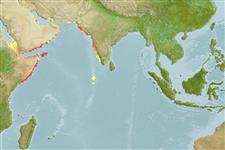Elasmobranchii (sharks and rays) >
Myliobatiformes (Stingrays) >
Dasyatidae (Stingrays) > Urogymninae
Etymology: arabica: Named for its type locality; noun in apposition..
Environment: milieu / climate zone / depth range / distribution range
Ecology
Marine; demersal; depth range 15 - 29 m (Ref. 110187). Tropical
Indian Ocean: Pakistan to India, in the Arabian Sea (Ref. 110187), with a first record of a possible immature individual from Sri Lanka (Ref. 120444).
Size / Weight / Age
Maturity: Lm ? range ? - ? cm
Max length : 45.0 cm WD male/unsexed; (Ref. 110187); 63.4 cm WD (female)
Short description
Identification keys | Morphology | Morphometrics
Vertebrae: 102 - 111. This species (with size at least 63 cm DW) is distinguished by this set of the characters: disc is broadly rhomboidal, its length 89-93% DW; snout is moderately elongate with small apical lobe, snout angle 113-121°; pectoral-fin apices are narrowly rounded; orbits small, protruding slightly; mouth is relatively narrow, its width 1.1-1.6 in internasal width; the distance between first gill slits 2.1-2.3 times internasal distance; distance between fifth gill slits is 1.4-1.5 times internasal distance, 28--30% of ventral head length; pelvic-fin base is narrow, 12-13% DW; a small yellow, seed-shaped suprascapular denticle followed by a slightly larger white, heart-shaped denticle; weak primary denticle band present in young but soon becoming inconspicuous; secondary denticle band is irregularly suboval, relatively narrow with well-defined lateral margins, rounded forward of orbit and not extending lateral to orbit even in large adults; adults with a broad band near tail base; dorsal disc uniformly brownish (lacking white spots); ventral disc pale with broad, weakly-defined and slightly darker margins; anterior tail light-brown on dorsal surface and usually without white lateral spots; tail banded dorsally behind caudal-sting base, bands more obscure or absent with age; pectoral-fin radials 127-135; total vertebral count, including synarcual centra 102-111, monospondylous centra 41-47, pre-sting diplospondylous centra 55-68 (Ref. 110187).
Immature male at 36.0 cm WD, while size at birth is probably slightly smaller than 17 cm WD (Ref. 110187).
Life cycle and mating behavior
Maturities | Reproduction | Spawnings | Egg(s) | Fecundities | Larvae
Manjaji-Matsumoto, B.M. and P.R. Last, 2016. Two new whiprays, Maculabatis arabica sp. nov. and M. bineeshi sp. nov. (Myliobatiformes: Dasyatidae), from the northern Indian Ocean. Zootaxa 4144(3):335-353. (Ref. 110187)
IUCN Red List Status (Ref. 130435)
Threat to humans
Harmless
Human uses
Tools
Special reports
Download XML
Internet sources
Estimates based on models
Phylogenetic diversity index (Ref.
82804): PD
50 = 0.5078 [Uniqueness, from 0.5 = low to 2.0 = high].
Bayesian length-weight: a=0.01622 (0.00606 - 0.04338), b=3.00 (2.77 - 3.23), in cm total length, based on LWR estimates for this (Sub)family-body shape (Ref.
93245).
Trophic level (Ref.
69278): 3.7 ±0.4 se; based on size and trophs of closest relatives
Fishing Vulnerability (Ref.
59153): Very high vulnerability (90 of 100).
